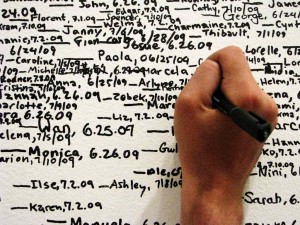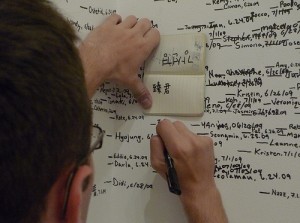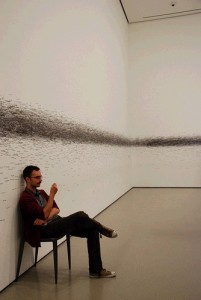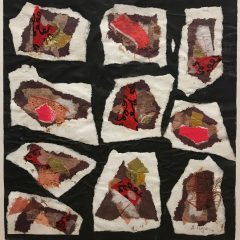Post by Joshua Weibley
The inspiration for this piece came when author Joshua Weibley was paid by MoMA to perform two artists’ work. During the course of one of these performances–when he was employed to execute Roman Ondák’s piece “Measuring the Universe” during the summer of 2009–he collected about 30 tourist photos of himself in action from online image-sharing websites. The images in the post come from the collection of tourist photos.
Take art as a series of images and take an image as the interrelationship of elements working together to form a singular impression: this definition accounts for images in painting that coalesce from brushstrokes, images in literature that coalesce from words and any other images produced by whatever means in the name of art.

This “working together” of elements on their way to constituting an image betrays the nature of images in art: they perform labor to produce meaning. (This is part of the phrase “it just works” that one might say when stepping back from a work of art.)
Now, meaning aside, value is applied to work speculatively. $15.00, for example, may be assumed to be the value of what a factory worker produces in the period of an hour, but that much value may not in fact be produced by the worker being paid it. The only constant material attached to $15.00/hr that can be verified is the presence of the worker. When there is no worker, there is no pay.

Because the presence of its workers (or performers) is the basis of performance, what is produced in performance work is inseparable from the process of producing it. This is to say that performance is inseparable from its value: it is immediately value-able, which is then to say that its evaluation is a part of the performance as well.
Appreciation—a name for evaluation which happens to imply monetary value—is, in fact, a parallel performance and like performance art, it is a kind of labor which can be held up for evaluation. “I value your opinion” is one (probably less than trustworthy) example of this kind of valuing being, in turn, valued.

All evaluations are not held equivalent though. Different opinions carry different import or value as an effect of the person whose experiences they emerge from. Connoisseurs, for instance, are so because they are known to have a critical facility (sometimes called “critical capital”) built up in experience: they know what they are looking for in something because they have a history of association and familiarity with it. Likewise, seasoned performers’ actions are preemptively treated as precious and their experience in practice allows them to know (so to speak) how to act.

It has, however, already been said that value is speculative: in evaluating it, one can have expectations of a thing based on past experience (which does heavily inform one’s perception), but one cannot know without experiencing it. This is how, similarly to performance, all that can be verified of evaluation as a process is the presence of an individual or body performing it.

Unlike other art forms submitted to the process of evaluation, performance disappears as quickly as it appears and what happens in that appearance can only be generally anticipated by a performer, much less so the audience. The work might not go according to plan, but that will simply become part of what receives value then and there.

No-one knows with any certainty whether a performance will be good, bad or if it will be met with indifference. All that is certain is the image of performance work these concerns provide. Two parties (performing bodies of the piece and those in the audience) will be present together in the occurrence of two valuable working processes unfolding simultaneously in a beautiful, momentary symmetry.









